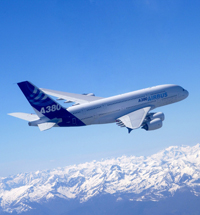May
28
Another Old Aerodynamic Assumption Bites the Dust
May 28, 2009 | 5 Comments
Logic, common sense and simple intuition suggest that the smoothest surface to reduce aerodynamic air drag would be the best for wings, propellers, hulls and bodies moving through the air. It looks like that seemingly obvious preconception is at an end.
The UK’s University of Warwick research, backed and funded by the Engineering and Physical Sciences Research Council (EPSRC) and Airbus, promises to dramatically reduce mid-flight drag, by using tiny air powered jets which redirect the air, making it flow sideways back and forth over the wing.
The key in this is air is forced into a cavity, which increases the pressure. That forces air out and sucks it back in again, causing an oscillation. It’s the same phenomenon that happens when blowing over a bottle. The jets work by using the Helmholtz resonance principle.
The math offers that wings designed with the air redirection could cut airline fuel bills by 20%. The design uses tiny air powered jets which redirect the air, making it flow sideways back and forth over the wing. A “waggle,” in the Brits idea of a descriptive term. Engineers have known for some time that tiny ridges known as ‘riblets’ – like those found on shark’s bodies – can reduce skin-friction drag, a major portion of mid-flight drag by around 5%.

Airbus In Flight. Tiny air powered jets redirect the air, making it flow sideways back and forth over the wing.
University of Warwick’s Dr. Duncan Lockerby, the project leader says, “This has come as a bit of a surprise to all of us in the aerodynamics community. It was discovered, essentially, by waggling a piece of wing from side to side in a wind tunnel.” There’s that “waggling’ word again, still absent a better description. He goes on, “The truth is we’re not exactly sure why this technology reduces drag but with the pressure of climate change we can’t afford to wait around to find out. So we are pushing ahead with prototypes and have a separate three year project to look more carefully at the physics behind it.”
I like this guy, honest enough to come out and say straight out that climate change is a pressure driving the work. I’ll take climate change as a motivator for efficiency, and if this work can greatly cut the cost of getting through the air at speed, its very worthwhile work.
The EPSRC Senior manager for aerospace & defense, Simon Crook says, “This could help drastically reduce the environmental cost of flying. Research like this highlights the way UK scientists and engineers continue to make significant contributions to our lives.”
The UK aviation industry has announced targets to reduce emissions based on a measure of per passenger km by 50% by 2020. That’s an aggressive goal. Part of these savings will be made from lighter aircraft plus improvements in engines and fuel efficiencies but air drag friction is the major factor in fuel consumption during flights. The new micro-jet system being developed by Dr. Lockerby and his colleagues could reduce skin friction drag by up to 40%
The Brits are serious, with a depth of understanding about the loads to overcome for flight with the research, being carried out in collaboration with scientists at Cardiff, Imperial, Sheffield, and Queen’s University Belfast. The research is still at concept stage yet it is targeted the new wings to be ready for trials as early as 2012.
With high probability for air flight success, this technology could also have a major impact on the aerodynamic design and fuel consumptions of cars, boats and trains that operate a much lower speeds.
The developed world has a great advantage with high-speed transport in economic scale. Moving people and goods makes a modern economy possible. People and leaders alike tend to overlook the value and costs of time. Only a century and a half ago getting across America was done at a walking pace, century ago at rail speed, a half-century ago at jet speed. Now an airline ticket is practical for most American’s making it possible for almost everyone get across the continent in a few hours.
This applies to freight, mail and other articles as well. The time not used is available for other things. That is one of energy’s best contributions to a modern economy and least considered issues for many. The idea of putting most people on bikes as an example, is a prescription for an incalculable economic contraction.
The Brits ideas to greatly reduce the energy needed to move at speed are very important, more so than first thought. I most want to say, “Go guys, GO!”
Comments
5 Comments so far


Thanks for writing, I very much enjoyed reading your most recent post. I think you should post more frequently, you clearly have talent for blogging!
Hi,
URL of this post looks strange. It has its job done but “newenergyandfuel.com/http:/newenergyandfuel/com/2009/05/28/another-old-aerodynamic-assumption-bites-the-dust/#comments” isn’t it little redundant?
PS:thanks for interesting site.
This post was very nicely written, and it also contains a lot of useful facts. I appreciated your distinguished way of writing the post. You have made it very easy for me to understand.
Heya i am for the primary time here. I came across this board and I in finding It really useful & it helped me out a lot. I’m hoping to provide one thing back and help others such as you helped me.
seo
Another Old Assumption Bites the Dust | New Energy and Fuel